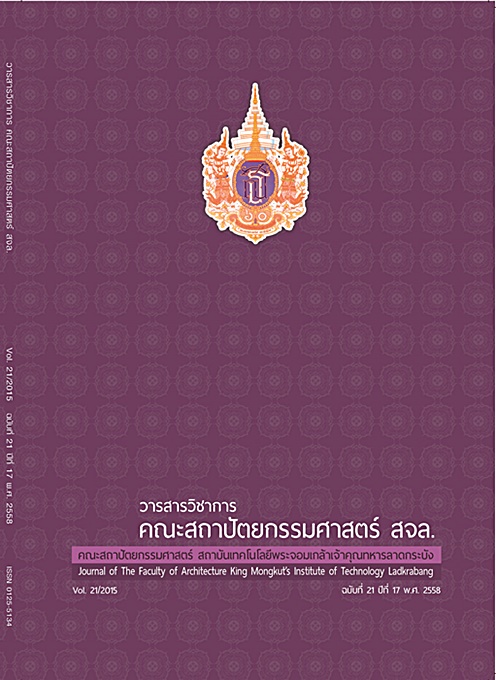มรดกสถาปัตยกรรมที่อยู่อาศัยแหล่งการดนตรีอาเซียน กรณีศึกษา: บ้านครูดนตรีไทย-ลาว (Residential Architectural Heritage of ASEAN Musicians: The Case Study of Thai and LAO National Musicians’ Residents)
Main Article Content
Abstract
บทคัดย่อ
มรดกสถาปัตยกรรมที่อยู่อาศัยเป็นรูปแบบทางวัฒนธรรมที่เกิดจากการสะท้อนภาพองค์ประกอบทั้งการใช้ประโยชน์ทางสถาปัตยกรรมและวัฒนธรรมวิถีชีวิตจนส่งผลให้เกิดเป็นเอกลักษณ์เฉพาะตัวของมรดกสถาปัตยกรรมนั้นๆ ซึ่งสามารถรับร้คูวามเป็นท้องถิ่นหรือความเป็นถิ่นที่นั้นๆ ได้อย่างชัดเจนเมื่อองค์ประกอบของภูมิทัศน์ในพื้นที่แห่งนั้นมีความชัดเจนและเป็นเอกภาพบทความทางวิชาการนี้เป็นข้อสังเกตที่ได้จากโครงการวิจัย “โครงการวิจัยสถาปัตยกรรมที่อยู่อาศัยและการดนตรีสู่สำเนียงดนตรีไทยร่วมอาเซียน” ซึ่งได้ใช้ระเบียบวิธีการดำเนินการวิจัยที่เน้นเชิงคุณภาพเป็นหลักแต่ยังคงผนวกกับการศึกษาสังเกตถึงรูปแบบการจัดวางผังอาคารการจัดวางผังบริเวณและการใช้ที่ดินโดยรอบตัวเรือนองค์ประกอบภูมิทัศน์และรูปแบบพื้นที่ในเชิงสังคมผลจากการศึกษาวิจัยพบว่ามรดกสถาปัตยกรรมที่อยู่อาศัยแหล่งการดนตรีเกิดจากการที่ศิลปินผู้อยู่อาศัยได้ปรับเปลี่ยนรูปทรงทางสถาปัตยกรรมเพื่อการอยู่อาศัยและวิถีชีวิตตลอดจนสภาพแวดล้อมโดยให้สัมพันธ์กับการจัดวางเนื้อที่ใช้งานทั้งภายในและภายนอกเพื่อตอบสนองกิจกรรมในการดำรงชีวิตได้อย่างเหมาะสมและยังสามารถปรับไปตามยุคสมัยได้อย่างประสานกลมกลืนกัน
คำสำคัญ : มรดกสถาปัตยกรรมที่อยู่อาศัย อาเซียน การดนตรี
Abstract
For better understanding in the identity of the residential architectural heritage of ASEAN musicians,the unique mixtures of cultural and natural environments including man-made environments have to be explored.According to the research, the Residential Architectural Heritage of ASEAN Musicians: The Case Study of Thai and LAO National Musicians’ Residents, this particular paper examines the architectural characteristics
through the explanation of the pattern of settlement and its surrounding, and building use and its space arrangement. The study mainly used qualitative techniques of primary data gathered. These were combined with on-site observation and reviews recorded for triangulation of information. The research findings illustrate that the cases consist of both tangible and intangible aspects of the cultural andarchitectural heritages. The residents can adapt themselves to respond to globalization and demands in their daily lives. However, at the same time, they still maintain their own cultural characteristics.
Keywords: Residential Architectural Heritage ASEAN Musicians
Article Details
This work is licensed under a Creative Commons Attribution-NonCommercial-ShareAlike 4.0 International License.
Copyright Transfer Statement
The copyright of this article is transferred to Journal of The Faculty of Architecture King Mongkut's Institute of Technology Ladkrabang with effect if and when the article is accepted for publication. The copyright transfer covers the exclusive right to reproduce and distribute the article, including reprints, translations, photographic reproductions, electronic form (offline, online) or any other reproductions of similar nature.
The author warrants that this contribution is original and that he/she has full power to make this grant. The author signs for and accepts responsibility for releasing this material on behalf of any and all co-authors.


